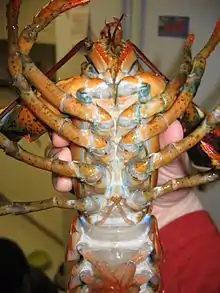Gonopore
A gonopore, sometimes called a gonadopore, is a genital pore in many invertebrates. Hexapods, including insects have a single common gonopore, except mayflies, which have a pair of gonopores.[1] More specifically, in the unmodified female it is the opening of the common oviduct, and in the male, it is the opening of the ejaculatory duct.

The position of the gonopore varies considerably between groups, but is generally constant within groups, allowing its position to be used as a "segmental marker". In Malacostraca, it is on the sixth thoracic segment; in Symphyla it is on the fourth trunk segment; in arachnids, it is on the second segment of the opisthosoma.[2] In insects and centipedes, the gonopores are close to the animal's tail,[2] while in millipedes they are on third body segment behind the head, near the second pair of legs.[3]
The positions of the male and female gonopores, either on the base of the leg or on the animal's sternum, is important in the systematics of crabs.[4]
See also
References
- Nikita Kluge (2004). "Morphology of mayflies". The Phylogenetic System of Ephemeroptera. Springer. pp. 21–54. ISBN 978-1-4020-1974-6.
- Alessandro Minelli, Giuseppe Risco & Nigel Hughes (2003). "Tagmata and segment specification in trilobites". In Richard A. Fortey (ed.). Trilobites and their Relatives: Contributions from the Third International Conference, Oxford 2001. Issue 70 of Special Papers in Palaeontology. Wiley-Blackwell. pp. 31–43. ISBN 978-0-901702-81-4.
- Hopkin, Stephen P.; Read, Helen J. (1992). The Biology of Millipedes. Oxford: Oxford University Press. ISBN 0198576994.
- Gary C. B. Poore, Shane T. Ahyong (2004). "Brachyura – crabs". Marine Decapod Crustacea of Southern Australia: a Guide to Identification. CSIRO Publishing. pp. 289–515. ISBN 978-0-643-06906-0.
